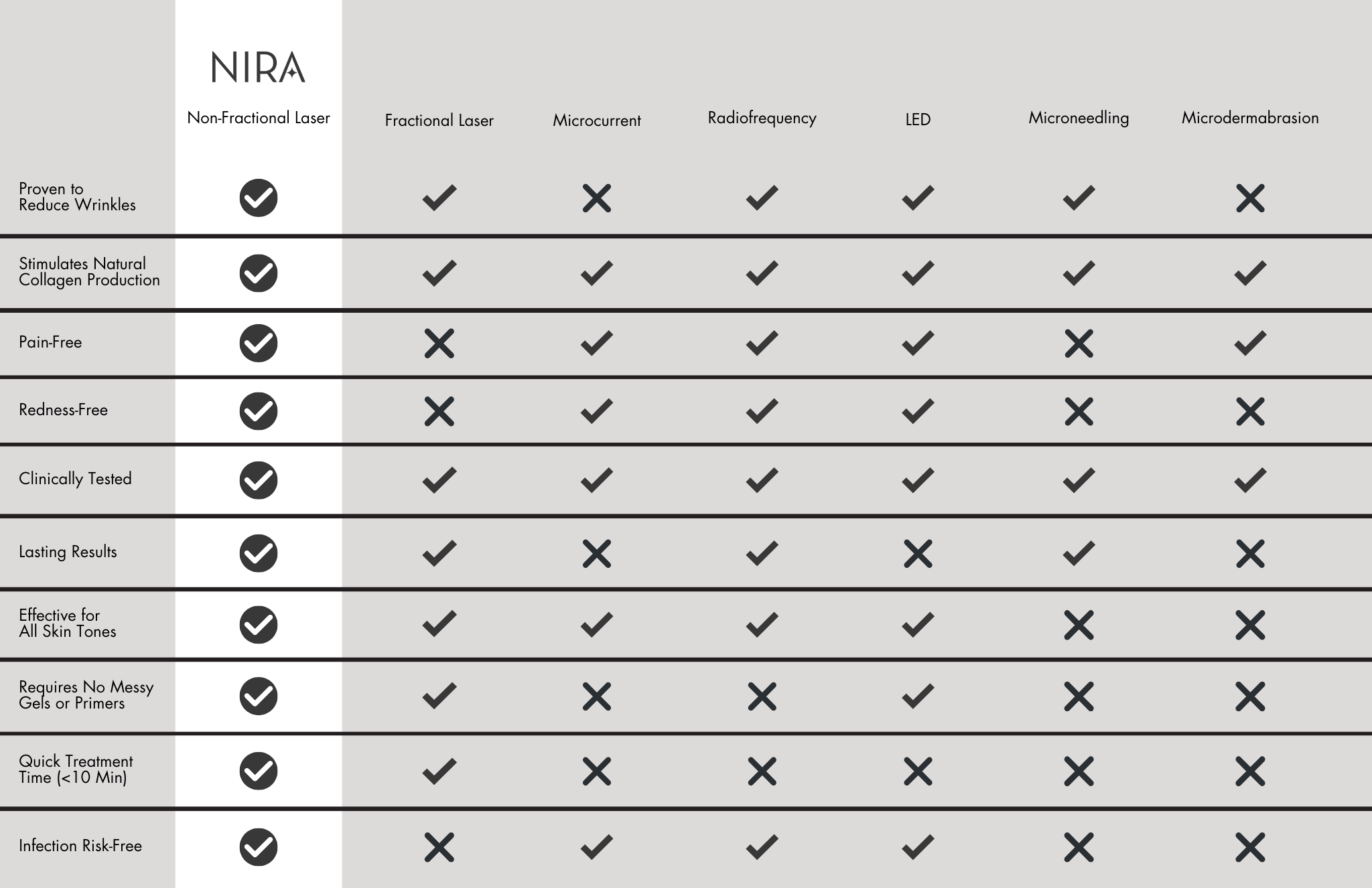TL;DR
Laser skincare improves texture, tone, and wrinkles by triggering collagen-but approaches differ. Ablative (fractional/CO2/Er:YAG) resurfaces for faster, dramatic change with more pain, risk, and downtime; non-fractional heats the dermis without removing skin, giving gradual results with minimal downtime and broader skin-tone safety. For at-home care, NIRA's non-fractional devices aim to deliver clinical-grade collagen stimulation without damage.
- Choose by goals & tolerance: need major resurfacing fast > ablative; want gentle, low-downtime, repeatable care > non-fractional.
- Plan for multiples: non-fractional typically needs consistent sessions; protect results with daily SPF.
- Targeting: use NIRA Precision for eyes/mouth and NIRA Pro for larger areas (face/neck/chest/hands).
Laser skincare is one of the most sought-after anti-aging treatments available today. With so many different types of laser treatments available, it can be overwhelming to decide which laser skin treatment type is best for you. But fear not, because we’re here to guide you through it. We’ll walk you through everything you need to know, from the benefits that come with different types of treatments to the potential downsides you should consider. In this guide, we will explore laser skincare and give you the power to make an informed decision about which method is best for your skin's health and appearance.
Understanding Laser Skin Treatments
Laser skin treatments are cosmetic procedures that utilize laser technology to improve the texture, tone, and overall appearance of the skin. It is a non-surgical treatment performed either in-office by a dermatologist or physician or by a handheld device at home to address various skin concerns and rejuvenate the skin.
During laser treatments, a high-intensity laser beam is targeted at the skin, either in an ablative or non-fractional manner, depending on the specific treatment approach. The laser energy is absorbed by the skin, creating controlled damage to the targeted areas, stimulating the body’s natural healing response to rebuild natural collagen and renew the skin.
There are two primary types of laser skin treatments:
Ablative Laser Resurfacing
Ablative lasers, such as carbon dioxide (CO2), Fractional, or Erbium lasers, work by removing the outer layers of the skin. This process prompts the regeneration of new, healthier skin cells and stimulates collagen production. This treatment type can be painful and damage the skin, causing redness and downtime. This process also can impact melanin causing certain areas of the skin to be lighter or darker post-treatment.

Pros and Cons of Ablative Laser Resurfacing
Like any cosmetic procedure, ablative laser skin treatments have their own pros and cons.
Pros:
- Wrinkle Reduction: Laser skin resurfacing effectively minimizes the appearance of wrinkles and fine lines, giving you a smoother and more youthful complexion.
- Scar Improvement: This treatment can significantly diminish the appearance of acne scars, surgical scars, and other types of scars, helping to improve skin texture and overall appearance.
- Sun Damage Reversal: Laser skin resurfacing targets sun-damaged skin by reducing sunspots, age spots, and uneven pigmentation, resulting in a more even skin tone.
- Collagen Stimulation: By stimulating collagen production, laser skin resurfacing promotes natural skin rejuvenation, increasing firmness, elasticity, and a more youthful appearance.
- Customizable Treatments: Laser skin resurfacing can be tailored to suit individual needs, allowing for precise targeting of specific areas and concerns.
Cons:
- Downtime and Recovery: Depending on the intensity of the treatment,ablative laser skin treatments may require a period of downtime for the skin to heal. Recovery time can vary from several days to a few weeks, during which redness, swelling, and skin peeling may occur. Non-ablative laser resurfacing is typically gentler, with minimal downtime and fewer side effects compared to ablative methods. It is commonly used to reduce fine lines, wrinkles, and acne scars and improve overall skin texture.
- Discomfort: While local anesthesia or numbing creams are used during the procedure, some individuals may experience discomfort or a mild burning sensation.
- Potential Side Effects: Although rare, laser skin resurfacing can carry potential side effects such as temporary changes in skin color, scarring, infection, or prolonged redness. These risks can be minimized by selecting a skilled and experienced professional.
- Sensitivity to Sun Exposure: After ablative laser skin treatments, the treated skin becomes more sensitive to sunlight. Sun protection measures, such as wearing sunscreen and avoiding direct sun exposure, are essential to prevent complications and maintain results.
- Price: Ablative laser resurfacing is generally more expensive than non-fractional treatments due to the higher intensity of the treatment. It is important to consider the financial aspect when opting for this type of treatment.
Non-Fractional Laser Treatments
Non-fractional lasers penetrate the skin without removing any layers or damaging the skin. These lasers target specific areas of concern, promoting collagen production and skin rejuvenation. This treatment type has no harsh side effects or impact on melanin, making it safe for all skin types and tones.

Pros and Cons of Non-Fractional Laser Treatments
Pros:
- Wrinkle Reduction: Non-Fractional laser treatments can effectively reduce the appearance of wrinkles and fine lines, resulting in a smoother and more youthful complexion.
- Scar Improvement: This type of laser treatment can significantly minimize the appearance of acne scars, surgical scars, and other types of scars, leading to improved skin texture and overall appearance.
- Pigmentation Correction: Non-fractional laser treatments target sunspots, age spots, and uneven pigmentation, helping to reverse sun damage and achieve a more even skin tone.
- Collagen Stimulation: By stimulating collagen production, non-fractional laser treatments promote natural skin rejuvenation, enhancing firmness, elasticity, and a more youthful look.
- Minimal Downtime: Unlike ablative laser treatments, non-fractional options typically involve minimal downtime and a quicker recovery period. This makes them suitable for individuals with busy schedules or those who prefer shorter recovery times.
- Customizable Treatments: By focusing on specific skin concerns and areas, non-fractional laser treatments can be customized to deliver precise results that address individual needs effectively.
Cons:
- Limited Results: This type of laser treatment may not deliver the same instant results as ablative treatments. They may require multiple sessions to achieve desired outcomes.
- Gradual Results: Non-fractional laser treatments typically produce gradual results, with improvements becoming more apparent over time as collagen production increases and skin rejuvenation takes place. Immediate and drastic changes may not be seen.
- Price: The cost can vary depending on the provider, location, and specific treatment plan. They may be more affordable than ablative treatments but still require financial consideration.
Non-fractional laser treatments can address a wide range of skin issues, including wrinkles, acne scars, sun damage, uneven pigmentation, age spots, and other signs of aging or skin damage. The procedure can be performed on various areas of the body, but it is most commonly used on the face.
NIRA Lasers utilize the only non-fractional, painless at-home laser technology, providing a safe and effective alternative for those seeking clinical grade results without the discomfort associated with traditional lasers. The NIRA Precision Laser has a small enough tip to target hard-to-treat areas around the eyes and mouth, whereas the NIRA Pro Laser has a larger treatment tip for larger surface areas like the full face, neck, chest, and back of hands. When combined, they offer the most powerful anti-aging treatment for home use.

Comparing Laser Skin Treatments to Other Anti-Aging Devices
While laser treatments are an effective option, other anti-aging devices are worth exploring. LED therapy, red light therapy, radiofrequency, and microcurrent treatments have recently gained popularity. However, laser skin treatments offer unique benefits, such as targeted treatment for specific concerns and greater precision in addressing deep wrinkles and scars.
NIRA's non-fractional laser device technology stands out as a pain and damage-free alternative to ablative lasers that provides exceptional results. The NIRA Lasers are an appealing choice for individuals seeking a safe and effective skin renewing treatment.


Laser Skin Treatments Unveiled
Laser treatments offer a powerful solution for addressing various skin concerns, from wrinkles and acne scars to sun damage and uneven texture. By understanding the different types of laser treatments available and weighing the pros and cons, you can decide which laser skin treatment type is the right choice for you.
Remember, your skin deserves the best care, and although ablative lasers may seem like the only transformative treatment out there, it’s not. Discover visibly dramatic results and explore clinically proven benefits of NIRA’s non-fractional laser technology today.




















